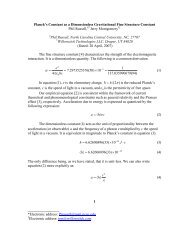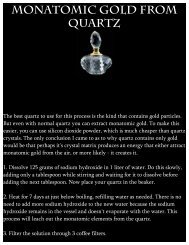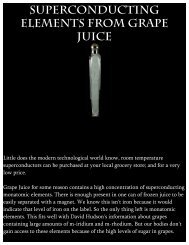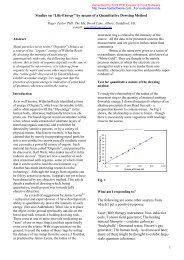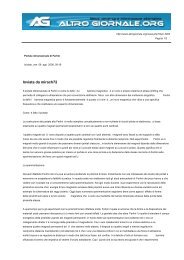Viktor Schauberger
Viktor Schauberger
Viktor Schauberger
You also want an ePaper? Increase the reach of your titles
YUMPU automatically turns print PDFs into web optimized ePapers that Google loves.
weapons. I have discovered for example a photo of a copy of the manned version of the<br />
V-1 – the Reichenberg – produced in Japan by Mitsubishi. The best fighter in the world,<br />
the push-pull twin propeller Dornier-335 was duplicated at the Kawashima works."<br />
This appears to be the extent of information that can be verified to a degree. However<br />
there is much more that „fits‟ within the known facts, but cannot be verified<br />
independently and therefore may well be fiction portrayed as fact. That said, much of<br />
the following information does flow with the themes explored further in the subsequent<br />
chapters of this book.<br />
Claims have also been made that Nazi Occult societies were involved in the<br />
development of such unconventional saucer craft. One such, the „Vril Society‟ was<br />
allegedly „channelling‟ messages from an alien civilisation in the Aldebaran solar system<br />
and planned to develop a craft that could make physical contact with the civilisation<br />
there. This may or may not be true; but there was certainly a high level of occult activity<br />
in mid-Europe at that time, and no doubt organisations did exist then with<br />
unconventional beliefs just as they do today.<br />
Whatever the truth of this, by 1934 the Vril Society had apparently developed its first<br />
UFO shaped aircraft, known as the Vril 1, which was propelled by an anti-gravity effect.<br />
(This was the same year as <strong>Viktor</strong> <strong>Schauberger</strong> discussed his flying disk ideas with<br />
Hitler.)<br />
The society then allegedly went on to develop this craft, and later - and again allegedly -<br />
produced the RFC-2. This craft was apparently 16 feet long and fitted with an improved<br />
propulsion system and for the first time, magnetic impulse steering. Interestingly, when<br />
in flight, it reportedly produced colour effects normally associated with UFOs.<br />
Yet the RFC-2 was largely ignored with only the SS showing an interest in the Vril<br />
Society‟s work. An inner organisation of the SS then set up its own SSE-4 department<br />
to develop new alternative technologies to ensure Germany no longer had to be<br />
dependent on external sources of energy and it began work on its own version of the<br />
RFC or Vril.<br />
By 1939 the SS had produced the RFC-5, which it called the Haunebu 1. In August<br />
1939 the machine made its maiden flight and proved its viability, being more than 65<br />
foot in diameter and offering considerable storage space. By the end of 1940 the RFC-2<br />
(Haunebu II) had entered service as a reconnaissance aircraft and there is certainly<br />
photographic evidence to support this, for example an RFC-2 was photographed near<br />
Antarctica in 1940 (see next chapter.) It should be noted that there is scant<br />
corroborative and historically verifiable information to support these claims, however the<br />
design of the Haunebu II should be noted for future reference.<br />
---------------------------------------------------------<br />
VRIL SOCIETY



